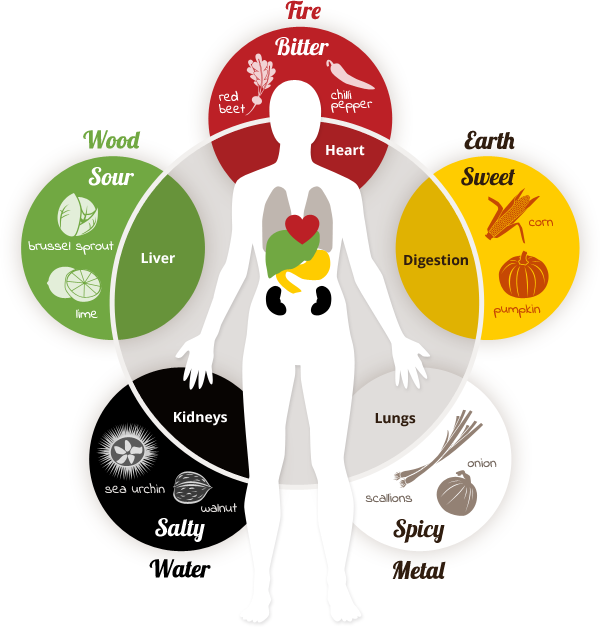Glossary
Since this glossary is primarily entrenched in Traditional Chinese Medicine theory, all the maladies listed will be broken down by what is referred to as ‘pattern differentiation’ in TCM theory. Every malady tends to have more than one pattern, sometimes even up to fives patterns, which means the cause/pattern for the malady is different for each person. With each malady there will be the TCM pattern/diagnosis, the relevant symptoms, and below that the foods which will help and those which are contraindicated/to be avoided. For the purposes of this site, only the most common patterns are included. You should try to find the pattern that has the most symptoms you are exhibiting, though you may not have all of them. As always, it is recommended that you go to see a doctor, nutritionist, holistic nutritionist or Traditional Chinese Medicine practitioner for further diagnostics and food therapy.
In Traditional Chinese Medicine (TCM) the five elements, known as Wu Xíng, are the pivot upon which diagnostic and treatment protocols spin. Much like a bee is attracted to a colorful flower with it's pollen beckoning and aiding in pollination, our body's systems are attracted to the five elements, each with a particular taste and color of food. This is the root of the most simple aspect of medicinal and seasonal eating according to Traditional Chinese Medicine principles. It is no accident that as the first ramps and Spring onions peak their green heads out of the soil, our liver, having worked hard all year and winter is ready for it's own Spring cleaning with green colored foods and sour flavors. Click over each element to the right and see how they correspond to not only your organs but what foods, colors, tastes, and emotions will affect each system.

- Main organ : heart
- Paired organ : small intestine
- Flavor : bitter
- Color : red
- Element : fire
- Emotion : anxiety
- Examples of foods which treat this system : beet root, parsley, garbanzo beans, red beans

- Main organ : spleen
- Paired organ : stomach
- Flavor : sweet
- Color : yellow
- Element : earth
- Emotion : worry
- Example of foods which treat this system : carrot, chicken, corn, millet, oats, sweet potato

- Main organ : lung
- Paired organ : large intestine
- Flavor : spicy
- Color : white
- Element : metal
- Emotion : grief
- Examples of foods which treat this system : chile peppers, garlic, onion, radish

Bibliography
- Weisman N., Ellis A., Fundamentals of Chinese Medicine. Brookline, MA: Paradigm Publications; 1996
- Pitchford, P., Healing with Whole Foods. Berekely, CA: North Atlantic Books; 2002
- Kastner J., Chinese Nutrition Therapy. Stuttgart. New York: Thieme; 2003
- http://kamwo.com/help/herb-guide.php



